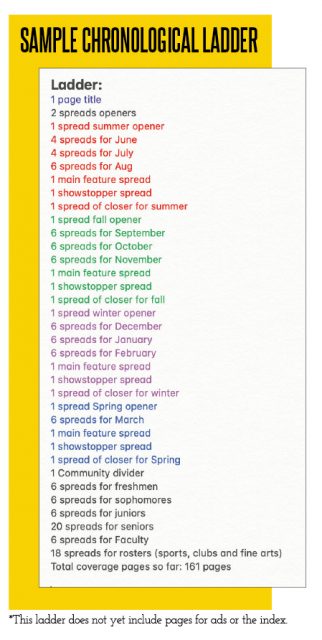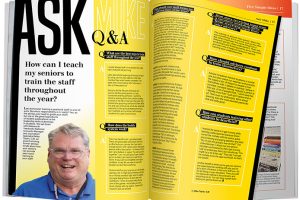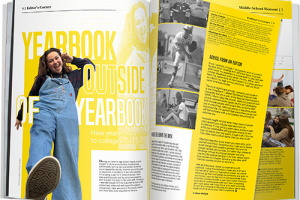
Now is the Time to Go Chronological
Taking a chronological content approach might be the best way to make sense of this unprecedented year. The sequence of content distribution requires deciding how to organize pages in a way that hooks the reader into the story, keeps their attention with an interesting and logical flow of information and doesn’t block signature submission. Here’s what you need to know.
What’s what
The sequence of coverage decides what kind of book we make: traditional, conceptual/umbrella or chronological.
- Traditional coverage groups pages in sections such as academics, sports, student life, clubs, ect. and focuses on what happens regardless of when.
- Conceptual/umbrella coverage organizes content based on categories or ideas that stem from the theme or fit under the larger umbrella of a certain topic.
- Chronological coverage presents school events according to when they happen: by seasons, months, weeks or days.
Award-winning books often use a combination of the three. My team organized our coverage chronologically by season and then in subdivisions for academics, student life, fine arts and sports inside each season. There were games, competitions, concerts and major recurrent events we could always expect: six spreads for sports in the fall, six spreads for sports in the winter, etc. We planned flex spreads knowing noteworthy and unexpected things come up, but we generally knew what would go on each page. The chronological order helped prevent deadline conflicts. Valentine’s Day would never be in the same signature as Homecoming or Halloween.
Why chronological? We don’t know what’s coming
Not all weeks and months are created equal, especially this year. A given week can bring 10 relevant and unique events, whereas the next one can barely have any. How do we plan for that? How do we allocate pages?
 What usually makes chronological tricky may be the flexible structure that fits the unprecedented year ahead. Due to the COVID-19 pandemic, many schools postponed fall sports seasons, actual daily or weekly class schedules are unknown and many students will start the year in some mode of distance-learning. Your coverage plan may need to be different, but there are still so many stories to tell.
What usually makes chronological tricky may be the flexible structure that fits the unprecedented year ahead. Due to the COVID-19 pandemic, many schools postponed fall sports seasons, actual daily or weekly class schedules are unknown and many students will start the year in some mode of distance-learning. Your coverage plan may need to be different, but there are still so many stories to tell.
Find a balance. Keep it manageable
Consider going monthly at most. This helps maintain interesting and relevant content that would not be sustainable or manageable at a more frequent pace. Use seasons, quarters or months as natural dividers.
Here are some tips:
- Create your ladder TODAY, knowing you will pivot. Be ready to remake that ladder and update it more often than ever before. Be ready to move pages and delete ideas. Have a running list of backups and more backups.
- Depending on school size, estimate 4-8 spreads per month. Be ready to move pages around if something doesn’t pan out.
- Include summer months in your coverage to give a good prologue to the story of the year. Set the stage; offer the backstory. Incorporate student and local/world events.
- Aim for balance, but don’t stress if months have differing numbers of pages. Let the book and its content reflect the “up in the air” nature of the times.
- Don’t force the content into a preconceived structure. Regular events might not take place, or at least not the same way.
- Rely on modular design strategies: alternative coverage modules might be one of the most powerful tools for your book this year. What happened this week? A bit of everything? Mods for the win.
- Use showstopper pages and special feature pages to highlight changes and prioritize student profiles to fill in gaps, increase student inclusion and tell unique and meaningful stories.
- Expand coverage on your people, roster pages and index pages, using them for events that don’t fit the corresponding time pages.
- Don’t go by academics, sports, student life, etc., but keep those categories present. Keeping a tally of what you add in each time-related section of the book will help you recognize topics you might have overlooked and will help you discover additional valuable stories.
Good things will pop up
These are serious, complicated and tragic times; however, good things will sprout out of nowhere. We cannot imagine them yet, but that’s the advantage of working with young, creative people. They adapt and innovate to make things work. Follow their lead and let them bring all their positivity and fresh ideas into the book. After 2020, yearbook production will not be the same. We are about to discover better storytelling strategies. We are about to become better scholastic journalists. Face the year with your eyes wide open and embrace the possibilities.



